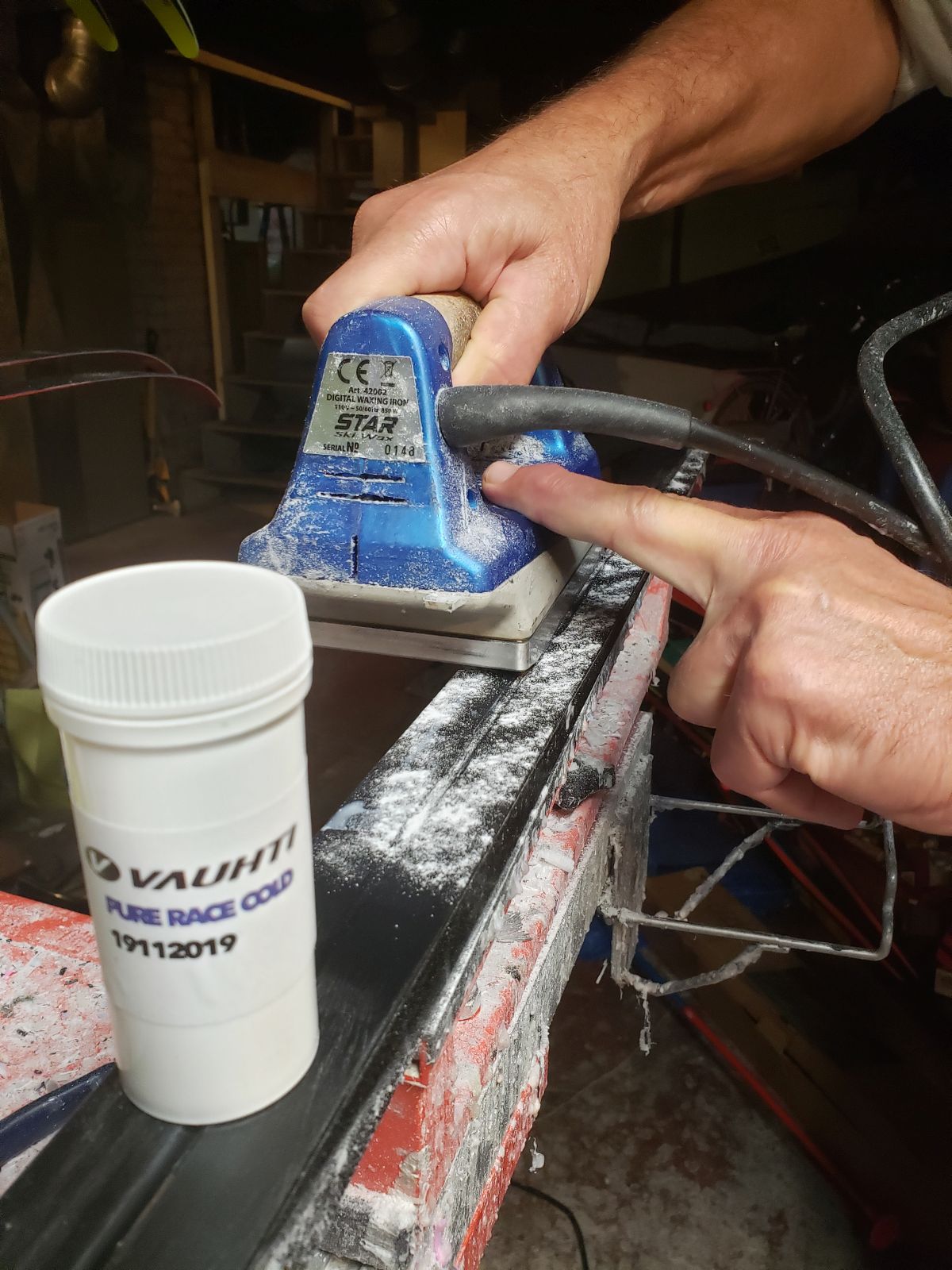January 16, 2022

After extolling the value of liquid ski glide waxes in the prior article it might surprise some that liquid glide waxes aren’t universally in use at high level ski racing. But not because they don’t perform! There are 3 reasons to continue to use the hot wax/iron system- 1. Time, 2. Durability for distance and in extreme temperatures, 3. Removing hand structure from the base.
At a national level race wax room the pressures are intense. Time is often a major factor, and surprisingly enough hot waxing can sometimes be faster than using liquids.
Liquids have an optimum cure time for performance, and while that cure time can be less important for most of us, a high-pressure wax station must test multiple test samples very quickly to arrive at the best wax for the day. A liquid wax might take 15 minutes to over an hour to cure; ironing can be very quick, the test ski placed outside to cool and then scraped, brushed, and ready to test in about the same time as a quick-cure liquid wax. The ironing often only allows for a single quick pass of an iron as all that is necessary is to make the solid wax flow evenly across the base. That’s it, no “absorption”, no “soaking”. And more to the point, after a winning wax is determined the race skis are prepped by running them once over a roller in a bath of molten wax. One pass! One thin layer of wax. However, it is true that for the the great majority of skiers, using a liquid wax and letting it sit followed by polishing with a soft brush is effective, easy to do, and less waste.
Noted in the prior article is that UHMWPE ski bases are not porous. No pores, no open spaces for wax molecules to slot into.
The incredibly long chains of carbon and hydrogen once compressed into the semi-crystalline UHMWPE materiel will mostly align tightly against one another with no space in between. This is the crystalline portion and is very important for providing the properties of slipperiness and resiliency. But the ends of the molecules can develop into something akin to a mess of cooked spaghetti noodles, and is aptly named the amorphous area. This portion of the base can react to specific heat levels and expand, and if wax molecules are present they can be accepted into the amorphous area into a sort of solution. Once this amorphous zone cools the new form stays together (mostly!). If the wax molecules are short single chains of Carbon and Hydrogen, the result is that the base will be a bit more greasy and slippery – think engine oil. High temperature ski waxes with long branched chains that are accepted into the amorphous zones will feel much harder and drier.
You can see this chemistry in action when the ski base gets really cold- the amorphous zones will contract and push out some wax. For race days in very cold conditions it is important to let the ski cool down outside as they will need another brushing out after a whitish bloom appears on the surface.
All of this means that the base material itself can be modified to support the primary thin running layer to reach a higher level of performance. Liquid paraffins do accomplish this but heating the bases allows a tighter bond in the amorphous zone, meaning the wax likely stays longer.
It is important to know that a really hard, high temperature glide wax isn’t automatically the best! Friction from snow is complex, and there’s a difference between high moisture snow where the friction comes from adhesion (what skiers call suction) or dry friction from the very sharp spines of new dry snow crystals biting into a too-soft layer of wax.
The modification of a ski base hardness isn’t all that easy to do or un-do. The amorphous zone might not react well unless heated close to the melting point of the plastic (often about 130-135C), so with glide waxes with low melt points a longer time with the wax in the melted phase might work better, but be careful not to overheat the ski itself (if most skis hit 70C and worry should ensue, 90C and you might just need to get a new ski). More importantly, any wax being applied will not replace but only mix with the wax previously applied to the amorphous zone!
It is of utmost importance that that when changing the characteristics of the base that the primary running wax not be mixed but be a true layer. That means a rigorous amount of brushing and cleaning to remove the wax on top of the ski base before adding the top layer.
If this sounds complicated, it is. And if you’re seeking top race level performance it is well worth doing. For the skier who enjoys just fast skis for athletic fun, perhaps not.
With the phase out of fluorocarbon waxes, the search for speed has emphasized the use of hand structure tools. Some skiers have been surprised that an appropriate hand structure will improve ski glide as much or more than a pure fluorocarbon top coat.
These structures are pressed into the base and with enough time will eventually “pop out” and revert to the original stone grind structure. The application of a hot wax will make this happen immediately, so if you use hand structure tools you’d better keep that iron!
Even if you are not podium bound you may find a super slippery ski a lot of fun- and worth keeping that iron around.
Especially when super cold temperatures are in the forecast!
Comments will be approved before showing up.